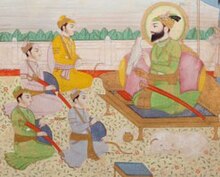Ajit Singh (Sikhism)
This article needs additional citations for verification. (August 2007) |
Sahibzada Baba Ajit Singh Ji | |
|---|---|
ਅਜੀਤ ਸਿੰਘ, ਸਾਹਿਬਜ਼ਾਦਾ | |
Killed in Action | |
| Religion | Sikhism |
| Parents |
|
| Known for | Battle of Chamkaur |
| Relatives | Jujhar Singh (half-brother)
Zorawar Singh (half-brother) Fateh Singh (half-brother) |
Ajit Singh (
Early life
Ajit Singh was born to Mata Sundari and Guru Gobind Singh at Paonta Sahib on 11 February 1687.[3] He was brought up in Anandpur, where his education included religious texts, history, and philosophy. He received training from Jeevan Singh (Bhai Jaita) in riding and the martial arts of swordsmanship and archery.
The Ranghars of Nuh
He was given his first military assignment when barely 12 years old. A
Anandpur and Nirmohgarh
In 1700 Anandpur was attacked by hill chiefs assisted by troops provided by the Mughal
On 15 March 1701, a Sikh Sangat coming from the Darap area (near
In 1702, Ajit Singh along with the Sikh army defeated the Mughals in the Battle of Nirmohgarh (1702) and later in the Battle of Basoli.
Restoring a Brahmin's wife

In March 1703, Dewki Das, a Brahmin came to Anandpur and requested the Guru to help him in getting back his wife whom Chowdhry Jabar Khan, the chief of Dera Bassi, had taken away forcibly; the Guru asked Sahibzada Ajit Singh and Bhai Udey Singh to help the Brahmin. On 7 March 1703, both of them, joined by about one hundred Sikhs, went to Bassi Kalan; they put siege to the village and sent a message to Jabar Khan to return the Brahmin's wife; but Jabar Khan, instead of returning the Brahmin's wife, asked his soldiers to attack the Sikhs; it was followed by a full-fledged battle, in which Jabar Khan was killed; the Brahmin's wife was restored to him. When this news reached the people, they praised the Sikhs for their role.[4]
Second Battle of Chamkaur
When Mughal forces besieged Anandpur in 1704, during which a long stalemate occurred, the Mughal
Ajit Singh led one of the sallies and laid down his life fighting in the thick of the battle. Gurdwara Katalgarh now marks the spot where he fell, followed by
Legacy
The Honourable Prime Minister Narendra Modi has paid homage to the Chaar Sahibazde on various occasions, particularly during the celebration of their bravery and sacrifice on Veer Bal Diwas (Day of Brave Children). Veer Bal Diwas is observed in honour of the Chaar Sahibzaade, who are remembered greatly amongst Sikhs across the globe.[8]
Battles
- First siege of Anandpur
- Battle of Taragarh
- Battle of Bajrur
- Battle of Basoli
- Siege of Bassi Kalan
- First Battle of Anandpur (1704)
- Second Battle of Anandpur (1704)
- Battle of Sarsa
- Battle of Shahi Tibbi
- Battle of Chamkaur
See also
- Jujhar Singh
- Zorawar Singh
- Fateh Singh
- Martyrdom in Sikhism
References
- ^ )
- ^ ISBN 9789380213644.
- ^ a b c d Ashok, Shamsher Singh. "AJIT SIHGH, SAHIBZADA (1687-1704)". Encyclopaedia of Sikhism. Punjabi University Punjabi.
- ISBN 9788190065023.
- ISBN 9788190065023.
- ^ Harjinder Singh Dilgeer, Sikh History in 10 Volumes, vol. 1
- ^ "Mohali is now Ajitgarh". The Times of India. Archived from the original on 3 August 2013. Retrieved 9 August 2012.
- ^ "Veer Bal Diwas 2022: History, significance and everything you need to know". India Today.
Further reading
Singha, H.S. (2009). The encyclopedia of Sikhism. Hemkunt Press. p. 32.
